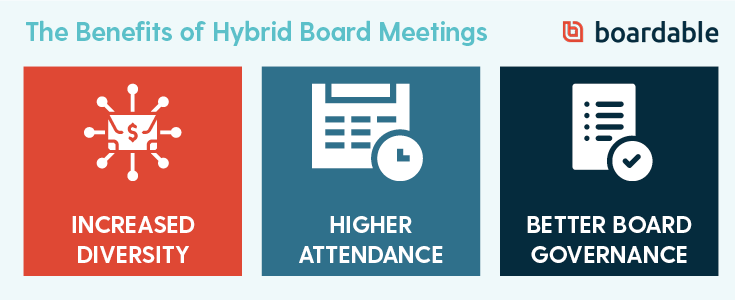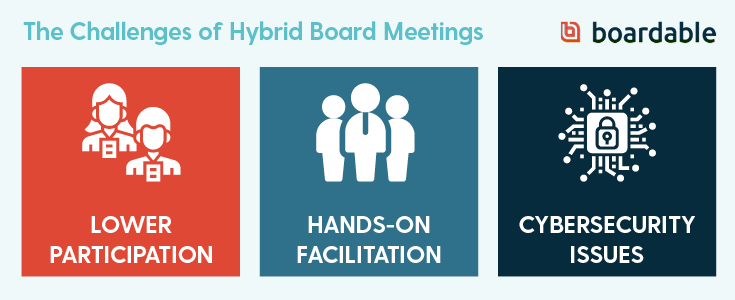While fully virtual strategies were sustainable at the peak of the pandemic, they’re not optimal for organizations that prefer connecting with supporters in person. With vaccines widely available, it’s becoming safer to meet face-to-face, which has organizations everywhere returning to in-person operations.
While you’ve likely considered what the hybrid model looks like for your fundraising efforts, what about how it will look for other aspects of your organization, particularly your board of directors? Your board must maintain momentum, and hybrid meetings enable everyone to come together safely. They allow part of your board to meet in person and another part to join virtually.
If you’re wondering what a hybrid work model means for your board, you’ve come to the right place. This guide will explore the ins and outs of hybrid board meetings, helping you optimize your approach and manage board member expectations to stay productive. We’ll cover:
- The Benefits of Hybrid Board Meetings
- The Challenges of Using A Hybrid Meeting Model
- Tips for Maintaining Momentum in a Hybrid Environment
Let’s dive in!
The Benefits of Hybrid Board Meetings
Understanding the advantages of hybrid meetings will help you envision what these gatherings might look like for your team. Plus, sharing potential benefits with your board will help gain their buy-in for the road ahead. Boardable’s hybrid board meeting playbook breaks the advantages down into three categories:
- Increase diversity by eliminating geographical barriers. You’ll open up the door to people across the entire globe, helping you to foster an inclusive culture and connect your board with a range of perspectives.
- Boost attendance rates by accommodating everyone’s schedules and eliminating travel time and expenses. If they don’t want to come in, all attendees need to do is sign in to your virtual meeting platform to collaborate with their fellow board members.
- Improve board governance by leveraging hybrid meeting tools. Advanced board meeting software helps free up time to focus on strategizing rather than counting voting ballots or taking minutes by hand.
Hybrid meetings have obvious benefits right now due to public health concerns about physical gatherings. However, these benefits will extend beyond the current landscape. Whenever you transition back to in-person operations, continue offering remote options to experience these advantages over the long term.
The Challenges of Using A Hybrid Meeting Model
While hybrid meetings are an increasingly popular approach for boards, there are some obstacles. However, with an understanding of what you’re up against, you can proactively prepare for any challenges and learning curves. Just like with the advantages we laid out, we can break down potential obstacles into three categories:
- There may be a dip in participation, mainly due to a lack of face-to-face interaction. Combat this with video conferencing technology, so all attendees feel included in the conversation.
- When everyone isn’t in the same room, it can be easy to lose focus. The board president will need to be hands-on with meeting facilitation, encourage active participation, and form detailed agendas to keep everyone on track.
- Introducing technology presents cybersecurity risks. Avoid complications with reliable technology that has proper security features, like secure socket layers (SSL) certification to encrypt data.
Actively prepare for these challenges and communicate with your board when you see warning signs of lower participation or security risks. Otherwise, engagement may drop, and board members may start mentally checking out of your meetings.
Tips for Maintaining Momentum in a Hybrid Environment
Whether you’re approaching your first hybrid meeting or refining your current approach, leverage strategies to put your in-person and remote attendees on the same wavelength.
Provide members with the tools they need.
Technology can enhance meetings when used efficiently. Remember, your board members volunteer their time to advance your mission, participating in everything from engaging major donors to acting as representatives for your cause. Always consider how your organization can support them in these tasks.
Here are a few tricks to simplify their shift to hybrid meetings so that they can continue to complete their work:
- Supply your board with tablets. Not everyone has the funds to splurge on a device to attend your hybrid meetings. Providing tablets can also help mitigate cybersecurity risks, allowing you to quickly wipe lost devices.
- Invest in board management software to centralize work. As Double the Donation’s nonprofit software guide explains, board portals come equipped with tools for collaborating anytime, anywhere. Choose technology that enables board members to vote remotely, attend your meetings, and complete follow-up tasks.
- Teach them how to use the technology. Similar to the learning curve some of your supporters likely face when participating in your virtual fundraisers, some of your board members may not be as tech-savvy. Show everyone how to review the agenda, join your meetings, vote, send chats, and complete any other tasks using their devices.
Giving your members the tools and knowledge to participate in hybrid meetings reduces the learning curve and enables them to focus on your mission. They’ll be more prepared to dive into their work when they’re not struggling to navigate hard-to-use tech.
Establish safety protocols.
Your board members are eager to get back in the boardroom. The last thing you want is to stifle excitement with poor safety precautions. For anyone who wants to attend in-person, ease health concerns by implementing precautions such as:
- Task a board member to send updates regarding ongoing CDC and state regulations.
- Enforce social distancing by blocking off every other chair in the boardroom.
- Supply masks for anyone who forgets theirs.
- Place bottles of hand sanitizer on the board table.
- Stagger arrival and departure times so everyone doesn’t show up or leave at the exact same moment.
Creating a safe meeting environment communicates that while your board members’ work is crucial, you still care about their health. For more ideas to improve safety measures, ask for feedback from board members to increase their comfort levels when attending in-person. Implementing their suggestions can be a great way to boost morale!
Lay down ground rules for meetings.
Hybrid meetings are new territory for most people, so give attendees some rules to follow. This will help eliminate roadblocks and ensure everyone respects one another. Members of the executive committee or the governance committee should hash out official rules before your first hybrid meeting, some of which might include:
- Mute the mic when not speaking. This eliminates background noise and echoes from board members who are in the same room.
- Eliminate distractions. Remote board members should find a quiet place to attend. Everyone should also close extra tabs to avoid clicking around during the meeting.
- Send a chat to indicate when you’re stepping away. That way, the secretary can make sure the minutes accurately reflect participation and attendance.
The board president should go over these expectations when introducing your new hybrid meeting model. Open the floor for questions to make sure it’s clear what’s expected. Then, at the start of each meeting, give an abbreviated guideline review as a friendly reminder.
Regardless of whether you’re excited about hybrid meetings or not, they’re the new norm for most organizations. They’re great for transitioning to in-person operations without risking anyone’s health or pressuring board members to come in. Your board will appreciate the convenience of working remotely and having the option to attend in person if they’d like, and their work will reflect that.




